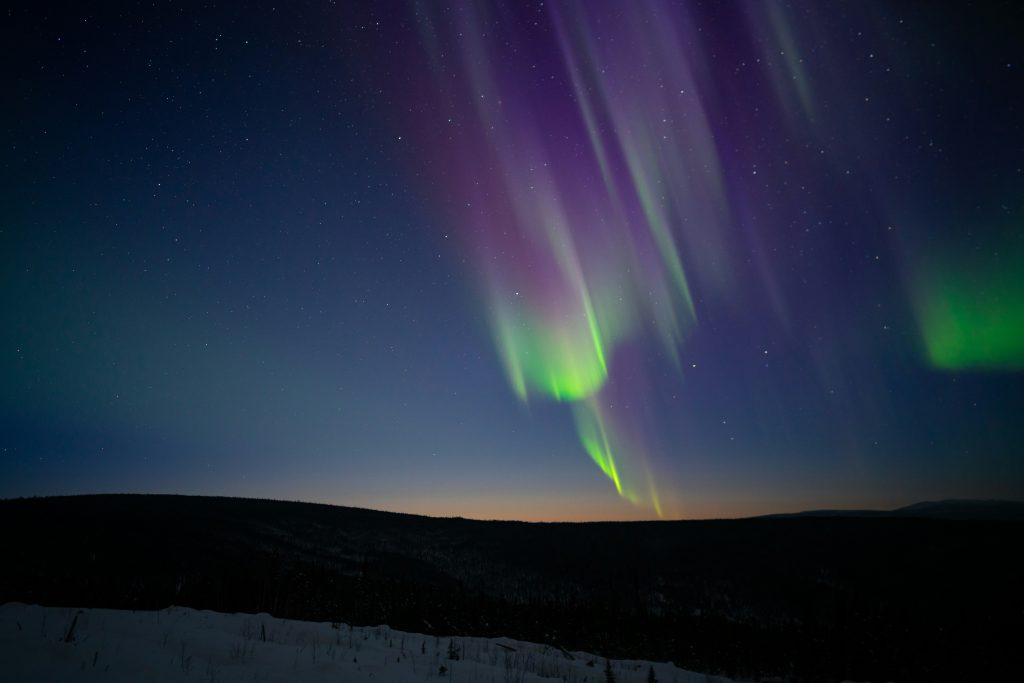A Spectacular Display of Northern Lights Captivates Skies Across North America
In an extraordinary celestial event, the Northern Lights, or Aurora Borealis, illuminated the night skies across various regions in North America, leaving spectators in awe. This breathtaking phenomenon was sparked by a coronal mass ejection from the Sun, which propelled charged particles toward Earth, creating stunning displays of light. Observers in states such as Maine, Washington, Oregon, and Michigan were treated to this natural spectacle, with reports of visibility extending even into California.
The recent occurrence coincided with the peak of the Perseid meteor shower, adding to the splendor of the night sky. Enthusiastic skywatchers gathered in locations like Joshua Tree National Park, where the vibrant colors of the aurora danced above them, creating a magical atmosphere. Such occurrences are rare, making the sight even more special for those lucky enough to witness it.
The Northern Lights are typically associated with the polar regions, but this particular geomagnetic storm created conditions favorable for sightings much further south than usual. Reports flooded in from various parts of the Northern Hemisphere, where the lights flickered and glowed in shades of green, pink, and purple.
As the solar activity continues, experts suggest that there may be additional opportunities to witness the Northern Lights in the coming nights, especially alongside the meteor shower. This convergence of celestial events has sparked excitement among astronomy enthusiasts and casual observers alike, who are eager to catch a glimpse of the natural wonders above.
For those interested in experiencing this phenomenon, the best viewing conditions include finding dark areas away from city lights and looking toward the northern horizon. The anticipation builds as scientists continue to monitor solar activity, providing updates on the potential for further displays of the aurora.
The beauty of the Northern Lights serves as a reminder of the wonders of our universe and the intricate dance between the Earth and the Sun. As communities come together to share in this experience, the event fosters a sense of unity and appreciation for the natural world.
With the combination of the Perseid meteor shower and the Northern Lights, this weekend has become a highlight for skywatchers, cementing its place in the memories of many. As we look to the skies, we are reminded of the beauty that lies beyond our daily lives, urging us to step outside and embrace the celestial wonders that await us.
Tags: Aurora Borealis, Celestial Events, Northern Lights, Perseid meteor shower
A Majestic Display: Northern Lights and Meteor Showers Dazzle Night Skies
As summer nights linger, skywatchers across the Northern Hemisphere are in for a spectacular treat. On the night of August 12th and 13th, the skies came alive with a breathtaking display of the Northern Lights, coinciding with the much-anticipated Perseid meteor shower. This rare celestial event captivated stargazers, offering a mesmerizing blend of vibrant auroras and shooting stars. The Northern Lights, or aurora borealis, are a natural phenomenon caused by solar winds colliding with Earth’s magnetic field. Recent solar activity, including a series of Coronal Mass Ejections (CMEs), has intensified the auroras, creating stunning colors that illuminate the night sky. Reports indicated that areas in Northern California were graced with these celestial lights, bringing joy to many who stayed up late to witness the magic. The excitement surrounding this celestial spectacle is not new; the Northern Lights have long fascinated those lucky enough to observe them. In regions like New England, sightings have become a cherished summer memory, with each event offering a unique and unforgettable experience. As clouds parted in various locations, stargazers were treated to an awe-inspiring show that reminded them of nature’s incredible beauty. This year, the Perseid meteor shower, one of the most renowned astronomical events, added an extra layer of wonder to the night. This annual shower peaks in mid-August, and when combined with the Northern Lights, it creates a rare opportunity for enthusiasts to experience two phenomenal displays at once. The National Oceanic and Atmospheric Administration (NOAA) issued alerts regarding the geomagnetic storms, which have been classified as G3 on their scale, indicating a strong chance for auroras to be visible in regions that typically don’t experience such displays. With the right conditions, stargazers in various states reported sightings, capturing the moment on cameras and sharing their experiences online. For many, witnessing the Northern Lights is a bucket-list experience, and events like these highlight the importance of astronomy and the wonders of our universe. In a world filled with distractions, taking the time to gaze at the stars can provide a sense of peace and connection to something greater than ourselves. As we look ahead, the combination of the Northern Lights and the Perseid meteor shower serves as a reminder of the beauty that exists in our cosmos, urging us to step outside, look up, and appreciate the extraordinary sights our universe has to offer. Whether you’re a seasoned astronomer or a casual observer, these moments are worth cherishing, as they are fleeting and rare. So mark your calendars for the next celestial events, and don’t miss the opportunity to witness the magic above. The night sky is waiting to be explored, and who knows what other wonders lie beyond our atmosphere?
Tags: Northern Lights, Perseid meteor shower
Breathtaking Perseid Meteor Shower to Illuminate the Night Sky
As the night falls, stargazers across the globe prepare for one of nature’s most spectacular displays—the annual Perseid meteor shower. This year, the meteor shower is set to peak tonight, offering a breathtaking opportunity for sky enthusiasts and casual observers alike. The Perseids are renowned for their intensity, with rates potentially reaching 100 meteors per hour at their peak. This celestial event, caused by Earth passing through the debris left by Comet Swift-Tuttle, promises to deliver a stunning visual feast for all who take the time to look up.
For those eager to witness this cosmic phenomenon, timing is crucial. The best viewing conditions will be from midnight to dawn, especially when the sky is darkest and the moon is less visible. Seek out locations away from city lights where the sky is clear and unobstructed, as this will enhance your viewing experience significantly. Popular spots often include parks, rural areas, and any open space that allows for a wide view of the night sky.
The Perseid meteor shower is not only a highlight of the astronomical calendar but also a time for communities to come together in appreciation of the universe. Many astronomy clubs and local observatories are hosting events to encourage public viewing, complete with telescopes and expert guidance. These gatherings can provide a wonderful opportunity to learn more about the stars and the science behind meteor showers.
This year has already been a remarkable one for astronomy, featuring various celestial events such as eclipses and auroras that have captivated audiences worldwide. The Perseids add to this list, reminding us of the beauty and wonder that the night sky holds. As meteors streak across the sky, leaving behind luminous trails, they evoke a sense of wonder and curiosity about the cosmos.
As the world moves towards increased appreciation for the night sky, events like the Perseid meteor shower serve as a reminder of our connection to the universe. Whether you’re a seasoned astronomer or someone simply looking for a magical night under the stars, the Perseids are an event not to be missed. So grab a blanket, invite friends and family, and prepare to witness the celestial fireworks tonight. The Perseid meteor shower is here, and it promises to be a night to remember.
Tags: astronomy, Meteor shower tonight, night sky, Perseid meteor shower, stargazing
Experience the Spectacle of the Perseid Meteor Shower This Weekend
As summer draws to a close, stargazers around the world are gearing up for one of the most spectacular celestial events of the year: the Perseid meteor shower. Peaking overnight on August 11-12, 2024, this annual phenomenon promises a dazzling display of shooting stars that captivates both seasoned astronomers and casual observers alike.
The Perseids, known for their bright meteors and high frequency, are active from July to September, with August marking their peak. This weekend is particularly special, as skywatchers can expect to witness an impressive flurry of meteors streaking across the night sky. Depending on viewing conditions, observers could catch sight of over 60 to 100 meteors per hour, making it an unmissable event for those who appreciate the wonders of the universe.
To make the most of this celestial show, experts recommend finding a dark location away from city lights, where the sky is clear and unobstructed. The best time to view the Perseids is typically after midnight, when the radiant point in the constellation Perseus rises higher in the sky. A blanket or reclining chair can enhance the experience, allowing viewers to lie back and take in the cosmic spectacle comfortably.
For those interested in the science behind the meteor shower, the Perseids are a result of the Earth passing through the debris left by the Comet Swift-Tuttle. As our planet travels through this cloud of particles, they enter the atmosphere at high speeds, burning up and creating the bright streaks of light that we see as shooting stars. This year’s shower promises to be particularly impressive, with optimal viewing conditions expected in many areas.
In addition to the sheer beauty of the meteors, the Perseid meteor shower holds a deeper significance as a reminder of our connection to the universe. It encourages individuals to step outside, look up, and contemplate their place in the cosmos. Whether you’re a devoted skywatcher or just someone looking for a fun evening activity, the Perseids provide a unique opportunity to witness the wonders of nature and the vastness of space.
So gather your friends and family, prepare for an evening under the stars, and relish the enchanting experience that the Perseid meteor shower brings. Don’t miss out on this chance to be part of a celestial celebration that has fascinated humanity for centuries. Embrace the moment, and allow the magic of the night sky to inspire you.
Tags: celestial event, Meteor shower, Perseid meteor shower, shooting stars, stargazing




